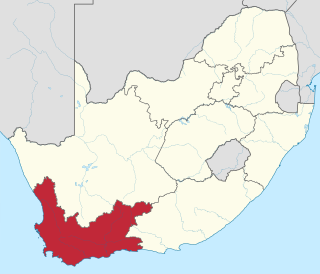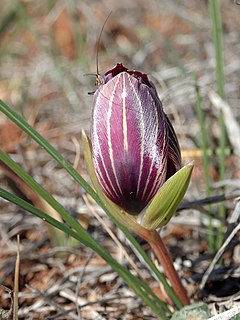
The Western Cape is a province of South Africa, situated on the south-western coast of the country. It is the fourth largest of the nine provinces with an area of 129,449 square kilometres (49,981 sq mi), and the third most populous, with an estimated 7 million inhabitants in 2020. About two-thirds of these inhabitants live in the metropolitan area of Cape Town, which is also the provincial capital. The Western Cape was created in 1994 from part of the former Cape Province. The two largest cities are Cape Town and George.

Gasteria is a genus of succulent plants, native to South Africa.

The Succulent Karoo is a ecoregion defined by the World Wide Fund for Nature to include regions of desert in South Africa and Namibia,and a biodiversity hotspot. The geographic area chosen by the WWF for what they call 'Succulent Karoo' does not correspond to the actual Karoo.

Eriospermum is a genus of tuberous flowering plants. It contains about 80-100 species, native to sub-Saharan Africa.

The wildlife of South Africa consists of the flora and fauna of this country in southern Africa. The country has a range of different habitat types and an ecologically rich and diverse wildlife, vascular plants being particularly abundant, many of them endemic to the country. There are few forested areas, much savanna grassland, semi-arid Karoo vegetation and the fynbos of the Cape Floristic Region. Famed for its national parks and big game, 297 species of mammal have been recorded in South Africa, as well as 858 species of bird and over 20,000 species of vascular plants.

Curio archeri, syn. Senecio toxotis is a species of succulent plant in daisy family that is indigenous to the south-western Cape, South Africa.

Astroloba spiralis is a small succulent plant of the Astroloba genus, endemic to the southern Karoo regions of the Western and Eastern Cape Provinces, South Africa.

Aloe speciosa is a species of flowering plant in the Asphodelaceae family. It is commonly called tilt-head aloe and is an arborescent aloe indigenous to the thicket vegetation of the southern Cape Provinces of South Africa.

Robertson Karoo is a semi-arid vegetation type, restricted to sections of the Breede River Valley, Western Cape Province, South Africa. It is a subtype of Succulent Karoo and is characterised by the dominance of succulent plant species, and by several endemic plants and animals.

Romulea monadelpha is a herbaceous perennial geophyte in the family Iridaceae native to South Africa. It has a small corm in the soil, a few thread-like leaves, and trimerous dark red flowers with elaborate markings on the inside near the bottom of the flower. It is called karoo satynblom in Afrikaans.

Dorotheantheae is a small tribe of annual succulents in the Aizoaceae subfamily Ruschioideae. Though it originally comprised three genera, Cleretum remains as the only recognised genus. Dorotheantheae are endemic to the western and south-western parts of South Africa. The type genus is Dorotheanthus, despite it being no longer recognised.

Eriospermum bowieanum is a species of geophytic plant of the genus Eriospermum, endemic to the Robertson Karoo region of the Western Cape Province, South Africa.
Eriospermum cooperi is a species of flowering plant of the Asparagaceae family. It is a summer rainfall species found in rocky grassland and open scrub from the Eastern Cape, South Africa to Zimbabwe. It has a solitary erect leaf, white to pale green flowers and grows to 60 cm. The outer tepals are sometimes reddish brown.
Eriospermum breviscapum is a species of geophytic plant of the genus Eriospermum, indigenous to South Africa.
Eriospermum dregei is a species of geophytic plant of the genus Eriospermum.

Eriospermum capense is a species of geophytic plant of the genus Eriospermum, indigenous to the Western Cape Province, South Africa.
Eriospermum bayeri is a species of geophytic plant of the genus Eriospermum, indigenous to the Western Cape Province, South Africa.
Eriospermum exile is a species of geophytic plant of the genus Eriospermum, indigenous to South Africa.

Protea canaliculata, also known as the groove-leaf sugarbush, is a species of flowering shrub of the genus Protea, which is endemic to the Cape Provinces of South Africa.
Protea restionifolia, which is also known as the Reed-leaf sugarbush, is a flowering shrub endemic to the Western Cape province of South Africa where it is found from the upper part of the Breede River Valley through the Bot River Valley to Wolseley and the Koue Bokkeveld Mountains.













